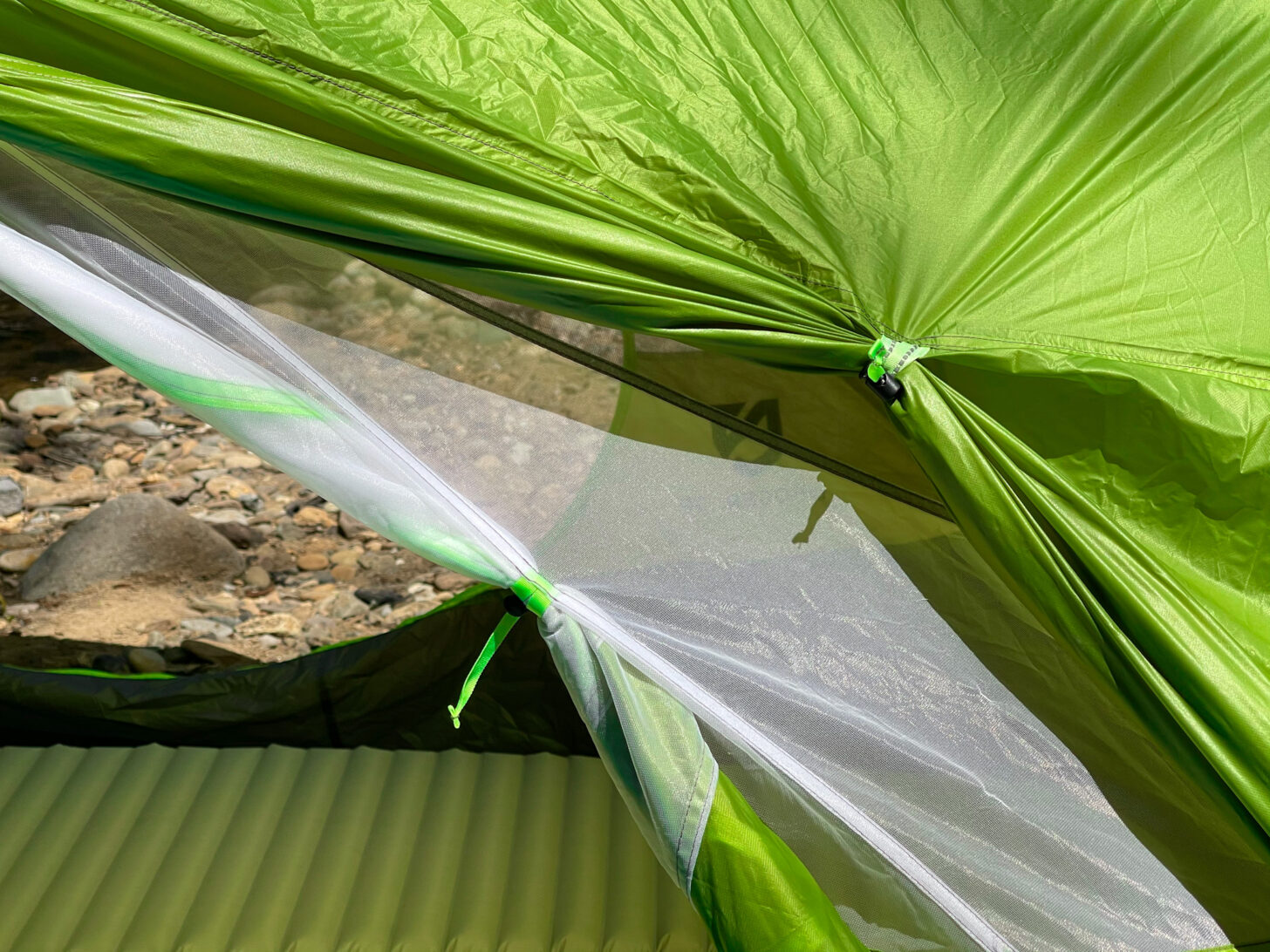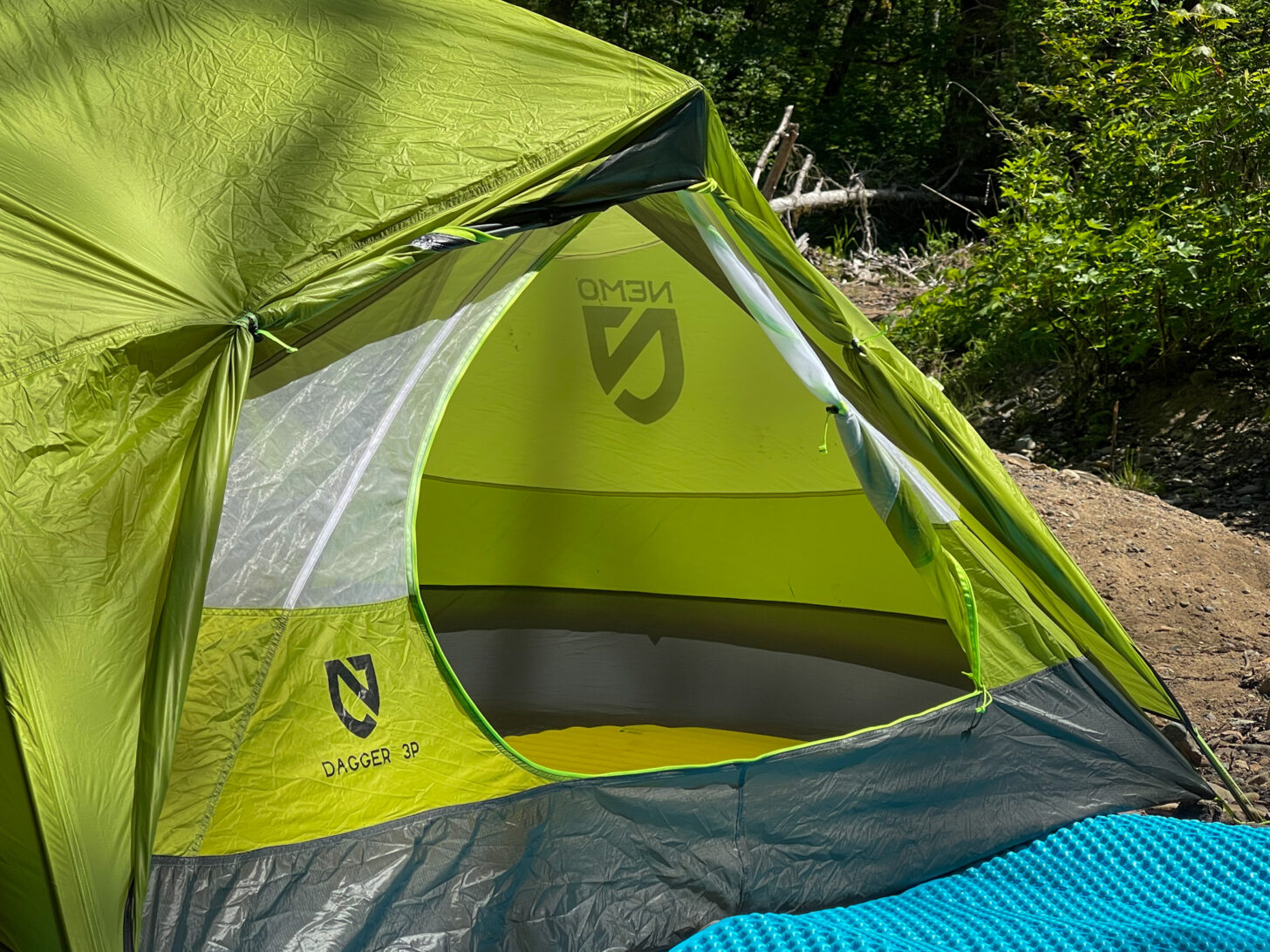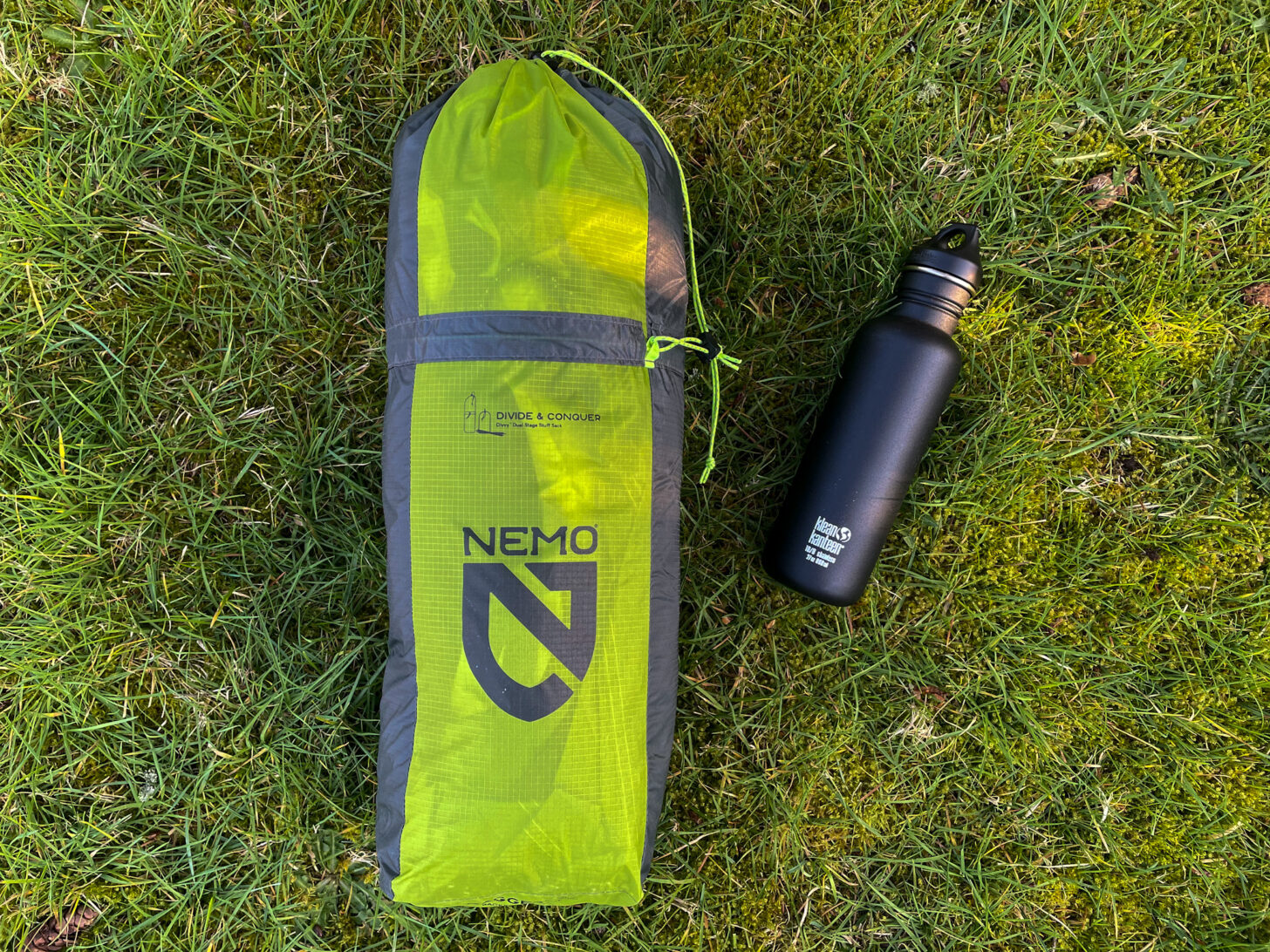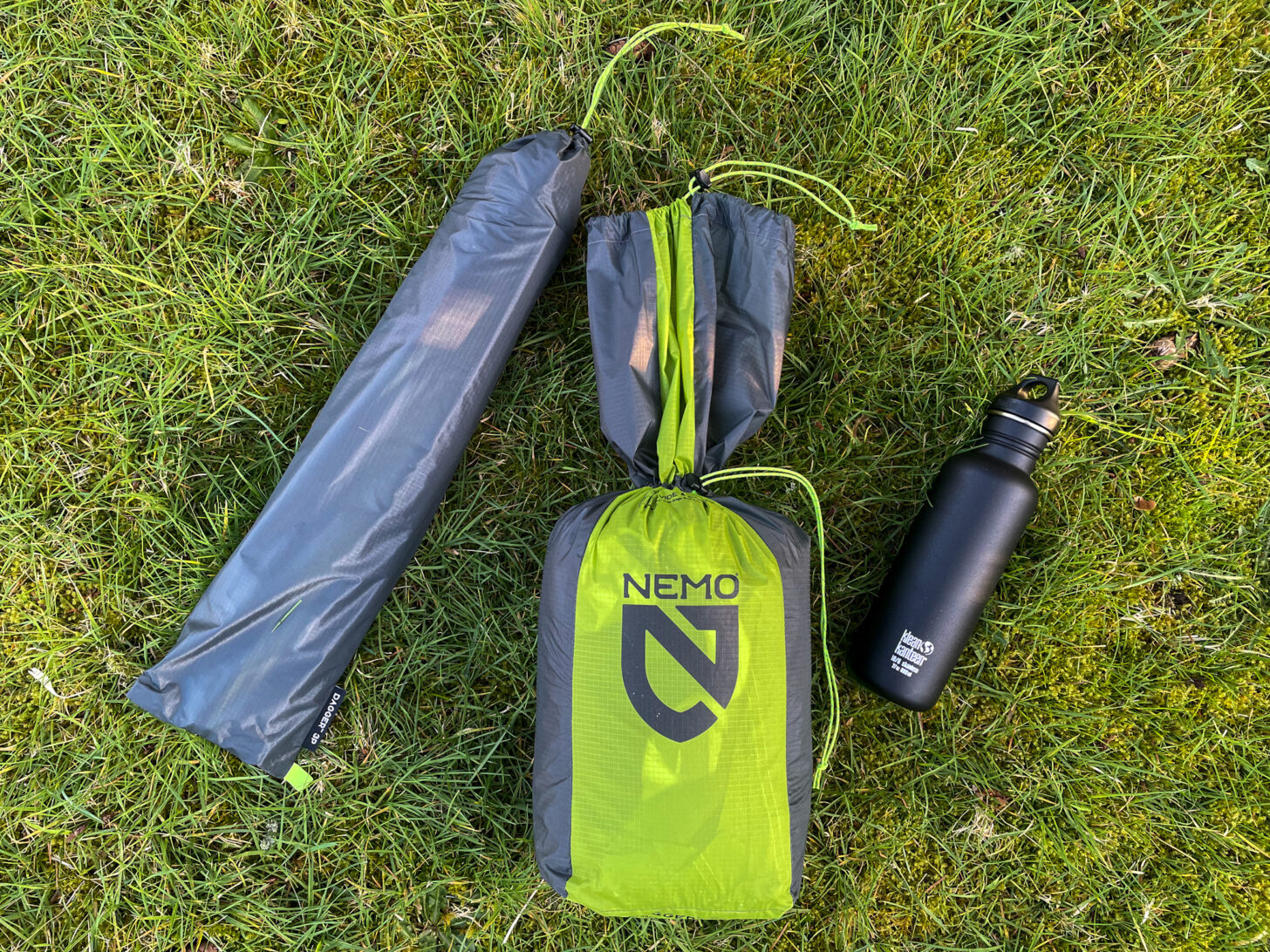Introduction
The Nemo Dagger 3P (4 pounds 5 ounces / 2 kg, MSRP $529.95) is a three-person, free-standing tent with roomy vestibules, light-diffusing overhead pockets, a stuff-sack system designed to help split the load amongst hiking partners, and pre-bent, color-coded poles (2019 update) for easy setup.
About This Review
This Limited Review draws on my experience with the Nemo Dagger 3P between December of 2020 and February of 2021 in the Central Cascades of Washington State. For this reason, I cannot directly speak to the breathability of this shelter when humidity increases and temperatures rise. Read about the differences between Performance and Limited reviews here.

Due to the restrictive circumstances surrounding COVID-19 during my testing period and the recommended social distancing guidelines, I decided to only include my partner and our dog as users, thus this review is unable to speak to the practicality of actually fitting three adults into the tent.
Features and Specifications
- freestanding, double-wall design
- two large doors with ample storage volume within each vestibule
- color-coded, pre-bent aluminum DAC Featherlite poles
- mesh side panels and canopy
- raised waterproof bathtub floor
- light-diffusing fabric panels designed to accommodate a headlamp
- dual-stage stuff sack
- pockets at each corner offer ample storage for personal items.
- strut vents at the top of each zipper flap
- NEMO Lifetime Warranty
- includes stakes, guy-out cord, repair kit, footprint sold separately
- capacity: 3
- seasons: 3
- frame: 1 Hubbed Aluminum DAC Featherlite NSL 9.6 + 9 mm pole
- minimum weight: 3 pounds 12 ounces (17 kg)
- packed weight: 4 pounds five ounces (1.95 kg)
- packed size: 19.5 x 6.5 inches diameter (50 x 17 cm diameter)
- peak height: 42 inches (106 cm)
- floor Area: 43.9 square feet (4.1 sq m)
- floor dimensions: 90 x 70 inches (229 x 178 cm)
- vestibule Area: 11.4 square feet (1.1 sq m) per vestibule, two vestibules total
- fly material: 15d Sil/PeU Nylon Ripstop (1200 mm)
- canopy material: 15d Nylon Ripstop and no-see-um mesh
- floor material: 30d Sil/PeU Nylon Ripstop (3000 mm)
Description of Field Experience
I tested the Nemo Dagger 3P in Mount Ranier National Park in the late winter of 2020. Winds during my testing period peaked at 10 mph. I experienced precipitation of 1 to 2 inches (3 to 5 cm) on each of my testing nights, with the final night receiving 3 to 4 inches (8 to 10 cm ) of rain/snow mix. Overnight lows ranged from 20 °F to 39 °F (−7 °C to 4 °C)
Performance Analysis
I judged the performance of the Nemo Dagger 3P based on the following factors:
- Setup: how easy and intuitive is setup, both solo and with a partner?
- Doors: are doors sized correctly and does the lightweight fabric of the doors/tent body seem to compromise the integrity of construction?
- Livability: what’s the comfort factor for two average-sized adults and one medium-sized dog? This metric includes storage both inside the shelter (pockets) and outside the shelter (vestibules).
- Ventilation: given the cold temperatures and three sets of lungs nestled inside, is ventilation an issue?
- Weatherization: how does the tent fare in wet and/or frosty conditions?
- Packability: whether carried as one unit or split between hiking partners, how does the packed size and weight stand up to scrutiny?
- Floor Durability: does the bathtub floor stand up to the expected rocks, roots, etc. at camp?
Setup
The freestanding, symmetrical design truly makes setup easy because it eliminates the guesswork in identifying and orienting the head or foot of the tent body, poles, and rainfly.
The pre-bent poles are easy to assemble; my one gripe is if you find yourself performing a solo setup while your hiking partner is wrangling the dog, fixing dinner, or busy with other camp chores, the single-pole design can make it a little awkward to control as it takes up quite a bit of space after assembled and laid out.

Creating the tent structure begins with snapping the hubbed ends of the poles into the socket pockets of what are known as Jake’s Feet, a Nemo-exclusive design for anchoring the poles and also attaching the rainfly. It should be noted that it takes some force to snap the poles into the sockets of Jake’s Feet, which I hadn’t read in any reviews during my research phase. Jake’s Feet are replaceable and also shelf staples at NEMO retailers like REI. This leads me to believe they will likely fail with overuse, too much force, or extended exposure to the elements.
However, the price point of $5 per Jake Foot is easy to swallow over mailing in your Nemo for repair. I might just recommend adding an extra Jake Foot or two to your packing list before heading into the backcountry, especially for extended trips.

The corners of the tent body are color-coded to match the corners of the rainfly so you can be confident in your setup of the Dagger. Just be mindful that the rainfly is right-side-out by ensuring the NEMO or Dagger logo reads left to right before attaching the hooks of the rainfly to Jake’s Feet. The hooking of the rainfly into the Jake’s Feet may also prove to be a point of failure over time, leading me to strengthen my recommendation to carry a few extra Jake’s Feet, just in case. Four points of staking for the rainfly vestibule means you can control which doors you wish to have open and rolled up at any time.
The reflective cords and bright fabric are a nice design feature that will also help you navigate your way around the tent if you find yourself doing a setup or making adjustments after sundown.
Doors
One thing I worry about with backpacking tents is the durability of the lightweight fabric used in construction, specifically with the doors. I’ve caught one too many doors in zippers, but the Nemo Dagger 3P gave me no issue whatsoever. In my opinion, both the freestanding design and the fabric used in the construction of the Dagger (15 denier Nylon Ripstop) helps a lot as it keeps the tent body stretched just enough to prevent any sag or flex, which could increase the likelihood of getting a door caught in the zipper.

The doors don’t mirror one another (ie. they open in opposite directions) so users are inclined to sleep head to toe. They also aren’t symmetrical or D-shaped like most other brands, which I found made it harder to open using only one hand.

Several reviews complained of the door size, but with me at 5 feet 6 inches (168 cm) and my partner at 5 feet 10 inches (178 cm), we didn’t find it to be much of a con. However, we could definitely see how someone 6 feet (183 cm) or taller might complain. That said, I feel like NEMO really maximized the size of the door based on the design and area given.
Livability
My partner and I found the Nemo Dagger 3P to be just spacious enough for us (again, me at 5 feet 6 inches / 168 cm and my partner at 5 feet 10 inches / 178 cm) and our medium-sized (40 pounds / 18 kg) dog plus our respective winter gear.

He and I slept on Therm-a-rest air pads (NeoAir Xlite and XTherm, both 20 inches / 51 cm wide) while a Therm-a-rest Zlite Sol foam pad was positioned between us for our dog to sleep on. The tent walls weren’t tight or stressed at all with our sleep system setup, however, the foam pad can easily slip under the air pads, thus lessening any potential stress on the tent walls and making it appear more spacious.

For this reason, I decided to try to mimic what a three-person sleep system setup might look/feel like by replacing the Zlite Sol with a Freestyle Lightweight Backpacking air mat from UST Gear (25 inches / 64 cm wide). Doing this experiment led me to believe the complaints I dug up in my research regarding the NEMO Dagger 3P being a tight fit with a three-person sleep system.

Storage is very generous with the NEMO Dagger 3P. Our packs laid flat in the vestibule without touching either the tent body or the rainfly. The interior also has two good-sized pockets on each side, plus some stash space in the overhead pockets made out of light-diffusing fabrics.
Ventilation
Instead of deployable vents in the side or roof, the NEMO Dagger 3P has a vent at the top of each vestibule door, which I personally like because I can adjust it as needed from inside. But as John with SwitchbackTravel.com points out, “by deploying the vent, you trim away the upper few inches of the door, making it a little more difficult to get in and out.” So that previous complaint about the doors being on the smaller side is now compounded.

As for the performance of the vents themselves, I had zero complaints. While weather conditions forced me to have the rainfly on during each of my field overnights, I didn’t find the expected morning condensation to be excessive.
My time with the Dagger was limited to winter, but I look forward to testing out the ventilation more when summer months arrive with the increase in humidity and temperatures. I’m already theorizing that the double-wall design and amount of mesh used in the construction of the Dagger aids tremendously in the breathability of the tent body.
Weatherization
Washington did not fail me in presenting optimal wet and frosty conditions to field test the NEMO Dagger 3P. As mentioned before, each of my overnights required the rainfly and I’m happy to report the quality of the waterproofing held up and we didn’t experience any leaks. However, the walls not covered by the rainfly were wet to the touch when the skies opened up for extended periods of time. This didn’t present much of an issue for two people and a dog, but it will likely be a complaint when capacity reaches three people and you can’t avoid touching the wet walls.


Size/Weight
With a packed size of 6.5 x 19 inches ( 17 x 48 cm), the NEMO Dagger 3P isn’t too bulky to fit whole in a backpacking pack, but Nemo came up with the Divvy Sack to allow users to split the poles and stakes from the tent body and rainfly to help distribute the load on extended trips into the backcountry. Once the hardware is removed, the Divvy Sack compresses to about two-thirds its original size and is cinched by a secondary drawstring. The convenience of splitting the load is so appreciated when pack weight becomes an issue on longer trips, but as I said, even if you decide to carry it whole, the packed size isn’t awkwardly large and overwhelming.


Floor Durability
NEMO sells footprints separately but takes pride in the tough 30 denier fabric used on the floor of the NEMO Dagger 3P. I decided to put it to the test by choosing not to use any footprint or groundsheet and what I found is it really does hold together quite well. After four overnights and an extended pitch in my backyard, the floor has zero snags or rips.
Commentary
For me, the NEMO Dagger 3P is a great tent for myself, my partner, and our dog. It will likely still be a great tent when our family grows by four more legs and a tail, but I think it’ll end there because of the complaints of a snug fit with a three-person sleep system setup.

I wonder how well the Jake’s Feet will hold up over time with continued use and also exposure to the elements. I’m going to add a few extra Jake’s Feet in my repair kit for extended trips.
An increase in floor space and headspace might sway me into feeling less claustrophobic and more comfortable using the Dagger 3P for three people instead of just two people and a dog or two.

If this were a Performance Review, I predict the NEMO Dagger 3P would get a Recommended rating. Three-person backpacking tents are snug because they’re backpacking tents, not extra-spacious car camping tents, and the Dagger gets it right by allocating generous amounts of vestibule storage to accommodate three people’s worth of backpacking gear. The Divvy Sack is a great design by NEMO for multiple users needing better weight management on extended trips. I look forward to field testing the Dagger during warmer summer months to experience nights of stargazing through the black no-see-um mesh on the roof of the tent body. Perhaps by then I can swap my dog out for another person to truly test out the three-person capacity.

Compared to
I compared the Nemo Dagger 3P to the Big Agnes Copper Spur HV UL3 Tent
Price
The Big Agnes Copper Spur HV UL3 is slightly cheaper ($499.95) than the Nemo Dagger 3P.
Edge: Big Agnes Copper Spur HV UL3
Weight
The Nemo Dagger 3P is 4 ounces (113 g) heavier than the Big Agnes Copper Spur HV UL3.
Edge: Big Agnes Copper Spur HV UL3
Packed Size
The two shelters have similar packed sizes.
Edge: tie
Liveability
The Nemo Dagger 3P has 4.8 sq feet more vestibule space than the Big Agnes Copper Spur HV UL3. It also has 3 sq ft more floor area.
Edge: Nemo Dagger 3P
Strengths and Limitations
Strengths
- Clever stuff sack system for dividing the load between hikers
- generous vestibules
- dual overhead light pockets
- price is on par with similar shelters
- NEMO lifetime warranty
- nicely sized for two people + dog
Limitations
- Jake’s Feet
- strut vent on vestibule door affects the ease of accessibility
- lowest peak height among comparable shelters
- snug fit with three people
Related Content
- Read our review of the NEMO Hornet Elite 2P
Discover and Research
- Browse NEMO products in our Gear Shop
- Engage with our community about three-person shelters in our forums.
DISCLOSURE (Updated April 9, 2024)




Home › Forums › NEMO Dagger 3P Review